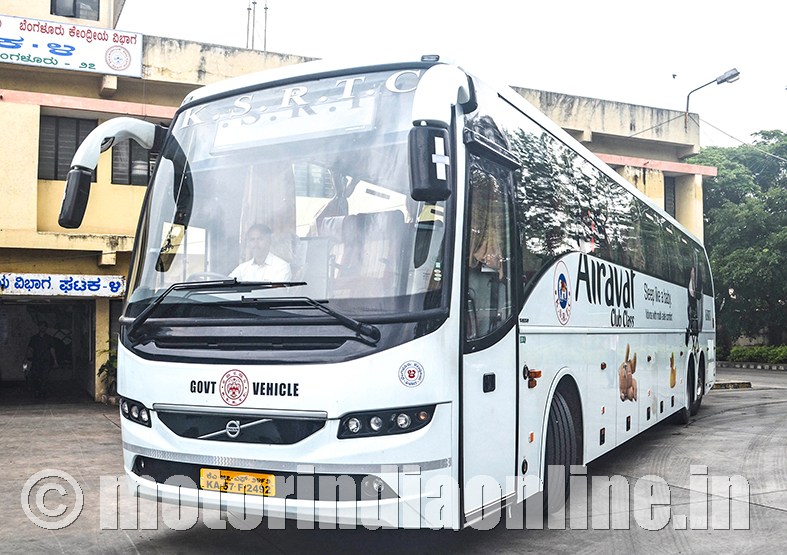The time when buses were no more than middling body panels and flimsy seats on a truck skeleton, the brand Volvo entered the Indian market with only world-class luxury products at its disposal. The domestic market neither had some sense of what new-age bus transportation is, nor was the market mature enough to afford such premium buses, not even the private fleets. Yet, the Swedish bus maker took the ardent challenge of graduating the Indian bus industry, more so without compromising on its technological superiority and premium lineament.

Just over one-half decades on, Volvo Buses has completely catapulted the local bus industry, not only by creating a new segment within on its very name, but also by increasing its market presence in terms of sales and service. The brand’s pioneering ideas like rear-engined buses, fully air-conditioned cabin, multi-axle coaches, ECU-governed braking and suspension, automated ‘i-shift’ transmission, etc., have set the agenda for the evolution of the industry in the years to come. The company is also playing a major role in promoting mass transportation, especially in offering comfortable and hassle-free transit solutions better than personal cars and other modes.
Mr. Suresh Chettiar, Business Head – Volvo Buses South Asia, and Vice President – Volvo Bus Corporation, answers to MOTORINDIA on key subject matters relating to maturation bus transportation and its service delivery in India, especially on the parameters of passenger safety, affordability, and sustainability.
Sustainable mobility and buses
India currently has just 1.7 milion buses, which is less than 1 per cent of the personal vehicle population. In other words, the share of public transport is among the lowest in the world. This reality is at the core of India’s emission and congestion challenges. Thus, India needs mobility that is sustainable in the context of a stable energy, technology and infrastructure evolution along with its environmental and social impacts.
The only way that personal vehicle owners will migrate to public transport is if the latter assures the same standards of vehicle performance, comfort, safety and reliability. Volvo Buses has answered this need along with other ‘premium’ bus manufacturers. But, if public transport has to be augmented, ‘premium’ buses must become the ‘standard.’ High quality products can deliver optimal life cycle benefits and there is a case for an adequate policy-triggered demand for quality buses. The resultant scale will drive a qualitative push.
Looking at the big picture, buses must be integrated into a city’s multi-modal public transport framework. For instance, high capacity buses and Bus Rapid Transit Systems (BRTS) can emerge as a more economical mode of mass transit vis-à-vis metro rail, without compromise on comfort, safety and reliability.
Reshaping buses in India
BS-IV emission norms are already in place, with BS-VI being mandated by 2020. This will bring India on par with the most stringent global emission standards. As technology begins to mature, the bus industry is likely to exhibit an increasing focus on lifecycle costs as opposed to sticker prices. This realisation has supported a collaborative approach around acquiring public transport rolling stock, maintenance and setting up of infrastructure.
The pace of change with the exception of that related to the enforcement of stringent emission norms is more or less a reflection of current market realities. It is quite surprising that critical aspects like A/C performance, driveability, noise and vibrations in a bus are still missing out. Not to forget that most of our innovated ideas and techs are now being seen in an increasing number of buses. Policy makers are doing their bit by rolling out progressive norms to enhance vehicle performance, safety and reliability and the adoption of e-mobility among other aspects. But clearly, there is a long way to go.
Finally, it is good to note that the public transport sector has been enthusiastic in its adoption of Intelligent Transportation Systems (ITS) to manage fleet and passenger information.
Expertise and R&D
The primary focus of our R&D programme is to ensure active and passive safety for all occupants of the bus. Similarly, considerable attention is provided to optimise passenger comfort. Over the years we have adapted and developed the products to suit to Indian operating conditions like road and climatic profiles as well as driving patterns and traffic behaviour.
When it comes to body building, we were the first manufacturers in India to develop a fully built bus and offer a world class product. Our facility is geared to develop high quality bodies, while being flexible to cater to specific customisation needs.
Comfort and safety
Ride comfort and safety are at the core of our value proposition. Since our Indian journey began, we have introduced buses with comfortable seats, electronic braking with ABS, electronic air suspensions, electronic stability control mechanisms, fire suppression systems among other features. These features have been instrumental in motivating commuters to switch from personal vehicles to buses. We observe that comfort and safety features pioneered by us are gradually being adopted by ‘mass market’ products.
Electrification and hybridization of buses
While being clear that clean diesel is unlikely to be completely replaced in the foreseeable future, the public transport industry has seen an increased momentum in favour of e-mobility. At a global level, Volvo Buses realised that e-mobility is a key megatrend well in advance. The first hybrid bus was rolled out in 2009. Today we have more than 4,000 electrified buses across the globe.
Volvo Buses appreciates that the current policy environment emphasises upon fast track introduction of fully electric buses. Going by our global experience, we believe that factors such as collaborative approach among e-mobility stakeholders, assured demand and lower cost lifecycle finance are key to the sustainable adoption of e-mobility. Volvo believes that electrified buses must offer at least the same levels of reliability, longevity and service delivery as the diesel buses they replace.
We are of the strong view that hybrids are a bridge between diesel and full electric buses. While delivering emissions reduction and fuel savings, they can directly replace diesel buses without the need for incremental infrastructure.
In India, we have supplied hybrid buses to Navi Mumbai. These buses have delivered savings of up to 35 per cent in fuel consumption and an even greater reduction in emissions relative to diesel buses. In operation, the hybrids have proven to reduce nitrogen oxides and particulate emissions by up to 50 per cent and carbon dioxide emissions by up to 40 per cent. We continue to map the Indian e-mobility landscape and will calibrate our market responses in sync with current and emerging opportunities.
Volvo’s growth
At present, the bus market is positioned at an inflection point. Given the right conditions, it can grow exponentially. Just to give you an idea of the vast potential, annual bus sales in India are 7-8 times lower than corresponding volumes in China. Volvo Buses has always led the product curve. We will continue to prepare well to cater to future demand patterns.
We strongly believe that our buses offer the best lifecycle value to Indian customers, with respect to their features and performance levels. As such, we recommend that tendering needs to be based on lifecycle value rather than immediate acquisition cost. In any case, economies of scale will arise from a uniform mandate for buses to meet globally benchmarked performance, comfort and safety standards. Such assured demand will support the Government’s ‘Make in India’ programme and bring down acquisition costs.
“Volvo Buses has always led the product curve. We will continue to prepare well to cater to future demand patterns. We strongly believe that our buses offer the best lifecycle value to Indian customers, with respect to their features and performance levels.
– Mr. Suresh Chettiar
